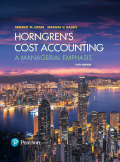
Concept explainers
Cash budgeting, budgeted
Refer to the information in Problem 6-42.
Budgeted balances at January 31, 2018 are as follows:
| Cash | ? |
| ? | |
| Inventory | ? |
| Property, plant and equipment (net) | $1,175,600 |
| Accounts payable | ? |
| Long-term liabilities | 182,000 |
| Stockholders’ equity | ? |
Selected budget information for December 2017 follows:
| Cash balance, December 31, 2017 | $ 124,000 |
| Budgeted sales | 1,650,000 |
| Budgeted materials purchases | 820,000 |
Customer invoices are payable within 30 days. From past experience, Skulas’s accountant projects 40% of invoices will be collected in the month invoiced, and 60% will be collected in the following month.
Accounts payable relates only to the purchase of direct materials. Direct materials are purchased on credit with 50% of direct materials purchases paid during the month of the purchase, and 50% paid in the month following purchase.
Fixed
All property, plant, and equipment acquired during January 2018 were purchased on credit and did not entail any outflow of cash.
There were no borrowings or repayments with respect to long-term liabilities in January 2018.
On December 15, 2017, Skulas’s board of directors voted to pay a $160,000 dividend to stockholders on January 31, 2018.
- 1. Prepare a
cash budget for January 2018. Show supporting schedules for the calculation of collection of receivables and payments of accounts payable, and for disbursements for fixed manufacturing and nonmanufacturing overhead. - 2. Skulas is interested in maintaining a minimum cash balance of $120,000 at the end of each month. Will Skulas be in a position to pay the $160,000 dividend on January 31 ?
- 3. Why do Skulas’s managers prepare a cash budget in addition to the revenue, expenses, and operating income budget?
- 4. Prepare a budgeted balance sheet for January 31, 2018 by calculating the January 31, 2018 balances in (a) cash (b) accounts receivable (c) inventory (d) accounts payable and (e) plugging in the balance for stockholders’ equity.
Want to see the full answer?
Check out a sample textbook solution
Chapter 6 Solutions
EBK HORNGREN'S COST ACCOUNTING
Additional Business Textbook Solutions
Essentials of Corporate Finance (Mcgraw-hill/Irwin Series in Finance, Insurance, and Real Estate)
Principles of Operations Management: Sustainability and Supply Chain Management (10th Edition)
Horngren's Financial & Managerial Accounting, The Financial Chapters (Book & Access Card)
Business Essentials (12th Edition) (What's New in Intro to Business)
Foundations Of Finance
Financial Accounting, Student Value Edition (5th Edition)
- Questionarrow_forwardI'm waiting for answerarrow_forwardMia Vision Clinic is considering an investment that required an outlay of $505,000 and promises a net cash inflow one year from now of $660,000. Assume the cost of capital is 13 percent. Break the $550,000 future cash inflow into three components: 1. The cost of capital. 2. The profit earned on the investment. Accounting Problemarrow_forward
 Principles of Cost AccountingAccountingISBN:9781305087408Author:Edward J. Vanderbeck, Maria R. MitchellPublisher:Cengage Learning
Principles of Cost AccountingAccountingISBN:9781305087408Author:Edward J. Vanderbeck, Maria R. MitchellPublisher:Cengage Learning Survey of Accounting (Accounting I)AccountingISBN:9781305961883Author:Carl WarrenPublisher:Cengage Learning
Survey of Accounting (Accounting I)AccountingISBN:9781305961883Author:Carl WarrenPublisher:Cengage Learning- Principles of Accounting Volume 2AccountingISBN:9781947172609Author:OpenStaxPublisher:OpenStax College
 Managerial AccountingAccountingISBN:9781337912020Author:Carl Warren, Ph.d. Cma William B. TaylerPublisher:South-Western College Pub
Managerial AccountingAccountingISBN:9781337912020Author:Carl Warren, Ph.d. Cma William B. TaylerPublisher:South-Western College Pub Financial And Managerial AccountingAccountingISBN:9781337902663Author:WARREN, Carl S.Publisher:Cengage Learning,
Financial And Managerial AccountingAccountingISBN:9781337902663Author:WARREN, Carl S.Publisher:Cengage Learning,





